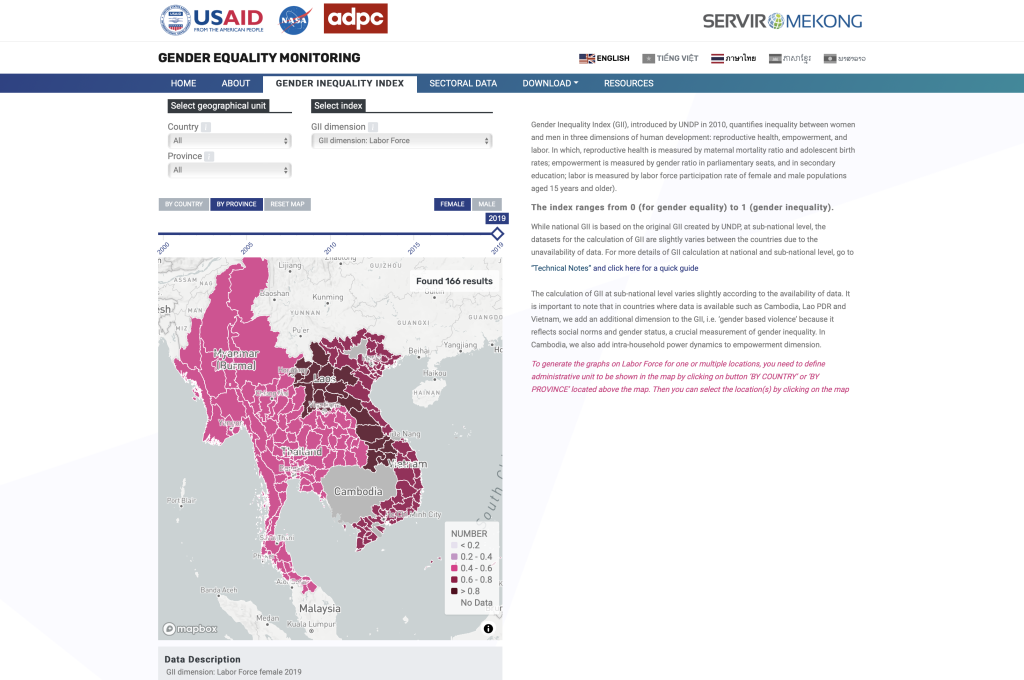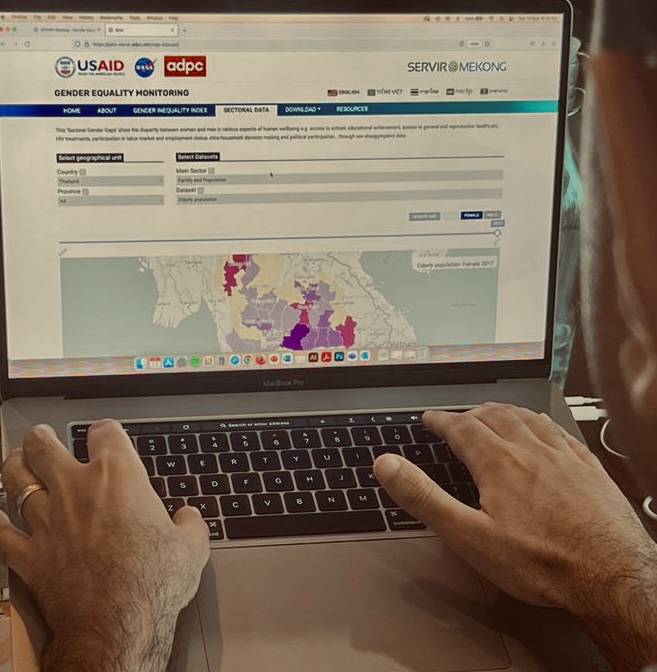SERVIR-Mekong Launches its Gender Equality Monitoring Platform to Leverage the Power of Geospatial Technologies to Promote Data-Driven Solutions that Enhance Gender Equality

On August 26, SERVIR-Mekong launched its Gender Equality Monitoring (GEM) Platform, which offers open access to published gender data and sex-disaggragated statistics. The data includes periodically-updated Gender Inequality Indices calculated sub-nationally for the Lower Mekong countries. GEM is an interactive, easy-to-navigate platform for policymakers, researchers, development practitioners, academia, the private sector, and gender equality advocates. It easily and understandably illustrates gender gaps, including comparisons within subnational or across national levels. Access to gender data and sex-disaggrated statistics means users can critically examine and track changes in gender inequality under different contexts, and over time.
This ability to critically examine long-term trends in gender inequality data is crucial in the development of evidence-based policies and programs. In the Lower Mekong Region, gender data and sex-disaggregated data can be hard to find and difficult to use, especially at the sub-national level. To address this, and in alignment with USAID's commitment to gender equality and social inclusion, the GEM Platform gives governments, civil society, and other organizations another tool to develop their gender mainstreaming activities more easily, rapidly, and effectively.
“GEM allows me to access and analyze gender-related data within hours. Prior to the GEM tool, it took days to access subnational gender-based violence datasets at the provincial level,” says Elizabeth Thipphawong, a Civil Society Specialist based in Lao PDR who works at the World Wide Fund for Nature (WWF) and USAID Mekong for the Future.
The GEM platform was developed by SERVIR-Mekong, one of five global hubs under SERVIR - a collaboration between the United States Agency for International Development (USAID) and the National Aeronautics and Space Administration (NASA) that helps regional institutions, governments and citizens use publicly-available satellite technologies to address climate-related challenges - and is implemented by the Asian Disaster Preparedness Center (ADPC).

What can GEM do?
- Understanding sub-national, national and regional gender (in)equality patterns, dynamics and trends in terms of (in)equality overall;
- Understanding sub-national, national and regional gender patterns, dynamics and trends in relation to specific sectors and topics, including nuance types of gender-based violence;
- Establishing baseline data for tracking gender inequality over time in specific contexts and/or sectors;
- Identifying gender data gaps at different levels and/or sectors;
- Enabling inter-ministerial cooperation on data collection, data sharing, gender analysis, and gender-responsive planning; and
- Catalyzing dialogue between public, civil, society and private sector actors on gender equality and addressing gender data gaps.
- GEM is customizable, including options for users to include additional datasets. Depending on the availability of data over time, the platform could also be used to visualize demographic changes in gender.
- “GEM is an extremely useful tool to visualize gender gaps at the regional level - beyond just one national indicator,” says Kalani Sachs Robertson of UN Women. “The sectoral data indicators, especially on women's empowerment, access to education, and gender-based violence allow us to target programmatic efforts towards the most vulnerable populations.”
Background: GIS to inform social policy and programming
Geographic Information Systems (GIS) allow international development agencies, policy makers, civil society organizations, and academics to analyze large and complex spatial datasets in sophisticated ways to achieve development outcomes. Over the last few years, use of GIS as a tool to study complex social variables, including gender, has increased. Integrating GIS with gender has several benefits. First, it places “people on the map,” by highlighting the plight of a section of the population previously ignored to be explored alongside other datasets. In addition, placing “people on the map” GEM allows for analysis of gender-differentiated impacts of environmental change on populations. Third, it allows for analyzing information at large scales, with information for large geographic areas.



